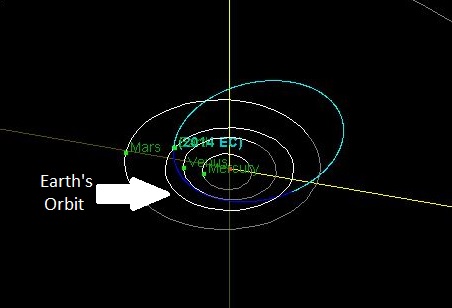We're all more aware of these small yet dangerous asteroids that slide right by the Earth because, one, NASA and others are getting better at discovering them on approach; and, two, there was that surprise meteorite that blew up over Chelyabinsk last year (see gallery below), injuring hundreds and generally freaking people out.As happens about 20 times a year with current detection capabilities, a known asteroid will safely pass Earth Wednesday closer than the distance from Earth to the moon.
This asteroid, 2014 DX110, is estimated to be about 100 feet (30 meters) across. Its closest approach to Earth will be at about 217,000 miles (about 350,000 kilometers) from Earth at about 1 p.m. PST (4 p.m. EST) on March 5. The average distance between Earth and its moon is about 239,000 miles (385,000 kilometers).
Now, as Slate reports, a smaller one will pass even closer tonight ... and of particular note, it was spotted just yesterday:
As the veil lifts and we humans get better at seeing just how much danger is circling our little blue life raft, scientists and enthusiasts are arguing that we need a plan. In response, the U.N. has established the International Asteroid Warning Network for that purpose.An asteroid called 2014 EC that was discovered only last night will pass the Earth just after midnight UTC tonight, sliding past us at a distance of just 56,000 km (35,000 miles) above Earth's surface! This rock is roughly 10 meters across - half the diameter of the Chelyabinsk asteroid. A miss is as good as a mile, as they say, but it shows that there are lots of these things passing us all the time.

"The residual impact risk - from asteroids with yet-unknown orbits - is shifting to small-sized objects," Peter Brown, a planetary scientist at the University of Western Ontario, told Nature recently.
The Associated Press added in a story last year about the dangers of these smaller, mostly undetected, near-Earth objects:
There's nowhere for us to go just yet, so perhaps we should take more seriously the efforts to guard our rock in space.Meteors about the size of the one that streaked through the sky at 42,000 mph and burst over Chelyabinsk, Russia, in 2013 - and ones even larger and more dangerous - are probably four, five or even seven times more likely to hit the planet than scientists believed before the fireball, according to three studies published Wednesday in the journals Nature and Science.
That means about 20 million space rocks the size of the Chelyabinsk one may be zipping around the solar system, instead of 3 million, NASA scientist Paul Chodas said at a news conference.




Seems to be a new normal in these close encounters: The near-misses have buddies that accompany them. It's easy to see how a rain of last-day-detected meteors could thwart any hopes of evacuations. A group of larger incomings will be leading the vanguard, towing in a fleet of Chelyabinsk whackers.
Evil attracts them like magnets.